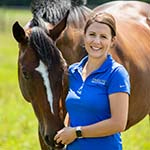Why Testing Hay is Important
Hay is a major component of the horse’s diet and often the one we know the least about because it doesn’t come with a tag. Testing hay allows us to definitively know the composition of our horse’s diet. A hay analysis is a helpful tool in many situations, including:
- A horse is not performing as expected.
- Breeding operations.
- Managing horses with metabolic conditions, such as Insulin Resistance, PSSM and RER where we are looking to limit dietary NSC (non-structural carbohydrate; sugar and starch) intake.
Hay Testing Process
The hay testing process starts with collecting a representative sample from each load of hay. A sample from a single bale or grabbing samples from several bales does not give a good picture of the average nutrients across the entire load of hay. Hay from different suppliers and even different cuttings from the same supplier should be tested separately.
A hay probe is used to collect a core sample from 10 bales or 10% of the load of hay, whichever is greater. Samples should be taken from the small end of small square bales and the round side of round bales. You can purchase a hay probe or often borrow one from your county extension office.
The samples you take from multiple bales are then combined together in a sealable plastic bag and mailed to a commercial laboratory for testing. Multiple labs offer forage testing services, but ensure that they are familiar with the nutrients of interest in horses. Some labs make this very easy by offering equine-specific packages. A testing package designed for livestock species will not give you all of the necessary information that is important in evaluating hay for horses.
Reading a Hay Analysis
Moisture: Optimal moisture ranges from 10-16%. Hay that has been overly dried will be brittle and in the case of alfalfa, lead to high leaf shatter. On the other hand, higher moisture hay (16%+) has a greater likelihood of developing mold, unless a preservative was used at baling.
Crude Protein: Crude protein (CP) content in hay will vary depending on variety (grass vs legume) and fertilization. Grass hays are lower in CP (7-14%) than legume hays (15-20%). Protein requirements vary with a horse’s age, stage of production and level of work. Crude protein of 12% or greater is generally appropriate for most horses. Hay with less than 10% CP would be considered low quality.
Fiber: The quality of fiber in horse hay is determined by NDF (neutral detergent fiber) and ADF (acid detergent fiber) values. NDF measures cellulose, hemicellulose and lignin. ADF measure cellulose and lignin. Increasing NDF and ADF levels are indicative of advanced forage maturity. Mature forages are less digestible and less palatable to the horse.
| High Quality | Moderate Quality | Low Quality* | |
| NDF | 40 - 50% | 50 - 60% | > 60% |
| ADF | 30 - 35% | 35 - 40% | > 40% |
*Refusals or significant intake reductions are seen with hay above 65% NDF and 45% ADF.
Non-Structural Carbohydrates: Non-structural carbohydrates (NSC) are measures of the starch and sugar in a feedstuff. NSC in hay is calculated as WSC (water-structural carbohydrates) + starch. WSC comprises sugars and fructans, a major storage carbohydrate of forages. Horses that are sensitive to NSC benefit from low (<12%) to ultra-low (<10%) hay, depending on the individual level of sensitivity. Forage is the largest source of NSC in most horse’s diets.
Calcium & Phosphorus: The total diet (forage + feed) calcium to phosphorus ratio should fall below 3:1 calcium to phosphorus for mature horses. Growing horses, as well as pregnant and lactating mares, should be fed a diet between 2:1 and 1:1 calcium to phosphorus to minimize the likelihood of Developmental Orthopedic Disorders.
If you would like help analyzing your hay analysis and forming a feeding plan, please contact us!

